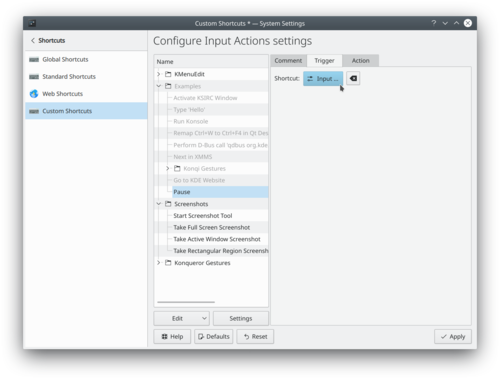Tutorials/hotkeys/da: Difference between revisions
Appearance
Created page with "* [http://www.linuxintro.org/wiki/oPen_a_conSole åbn en konsol]" |
Created page with "* kør kommandoen <code>systemsettings</code>" |
||
| Line 5: | Line 5: | ||
* [http://www.linuxintro.org/wiki/oPen_a_conSole åbn en konsol] | * [http://www.linuxintro.org/wiki/oPen_a_conSole åbn en konsol] | ||
* | * kør kommandoen <code>systemsettings</code> | ||
* select <menuchoice>Shortcuts and Gestures -> Custom Shortcuts -> Edit -> New -> Global Shortcut -> Command/URL</menuchoice> and enter <code>Pause</code> | * select <menuchoice>Shortcuts and Gestures -> Custom Shortcuts -> Edit -> New -> Global Shortcut -> Command/URL</menuchoice> and enter <code>Pause</code> | ||
Revision as of 06:00, 28 January 2015
I KDE kan du få enhver tast eller tastekombination til at udløse en handling på din computer. For eksempel: Når jeg holder pause fra mit arbejde, så vil jeg have min skærm låst ved at taste Pause, sådan at mine kolleger ikke kanbaggy-pantser mig.
- kør kommandoen
systemsettings
- select and enter
Pause
- In the tab, click on
- press the Pause key
- go to the tab
- enter
qdbus org.kde.screensaver /ScreenSaver org.freedesktop.ScreenSaver.Lock
or (whatever works)
/usr/lib64/kde4/libexec/kscreenlocker_greet
or (whatever works)
/usr/lib64/kde4/libexec/kscreenlocker --forcelock
- click
- test it by pressing the Pause key

